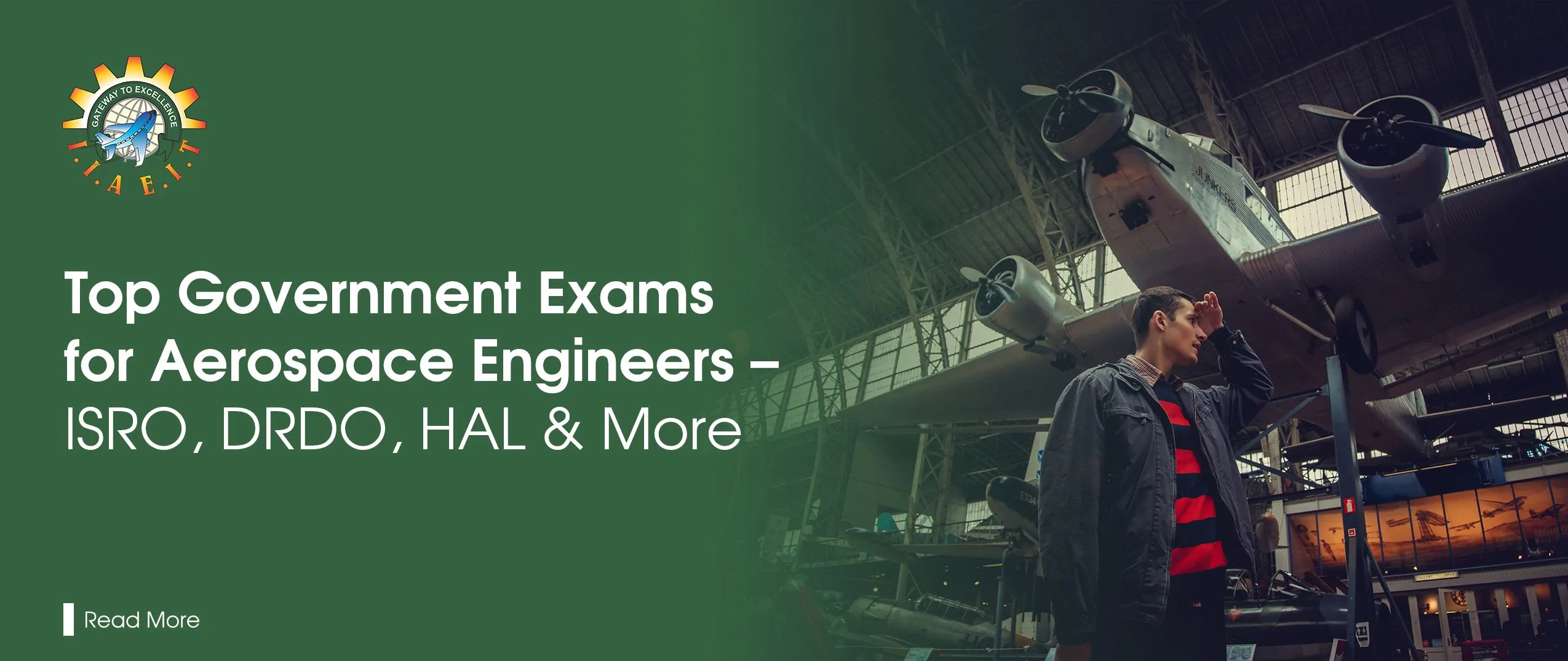Aerospace engineering is one of the most exciting yet challenging engineering that involves the design, development, testing, and maintenance of aircraft and spacecraft. In India, where space missions and defence advancements are making global headlines, aerospace engineers have a critical role to play.
For the students looking for stable, prestigious, and meaningful careers, government jobs and Public Sector Undertakings (PSUs) offer a great opportunity. This blog delves into the top government exams and PSUs for aerospace engineers in India. It’ll give you a brief idea of what to aim for, how to prepare for it, and where these paths can land you.
Why should you choose a government job as an aerospace engineer?
Government and PSU jobs in aerospace engineering offer more than just employment; they offer a purposeful career path. Organisations like ISRO, DRDO, HAL, and others are at the forefront of India’s defence, aviation, and space technology.
Some of the key benefits include:
- Job stability and long-term career growth.
- Opportunities to work on cutting-edge technologies.
- Work-life balance and social respect.
- Competitive salaries and retirement benefits.
If you’re a student pursuing or have completed an aerospace engineering degree, several government examinations and PSUs are open to you. Let’s understand this.
Top Government Exams For Aerospace Engineers
1. GATE (Graduate Aptitude Test in Engineering):
The GATE Exam is the road to bright opportunities. It serves two major purposes.
- Admission to postgraduate programs (M.Tech/Ph.D.) in top institutes
- Recruitment into PSUs such as HAL, BARC, and even DRDO (in some cases).
A strong GATE score makes you eligible for interviews and shortlisting by various PSUs and R&D institutions.
2. ISRO Centralised Recruitment Board (ICRB)
ISRO is the dream workplace for many aerospace engineers. The ISRO Scientist/Engineer exam, conducted by ICRB, is your direct path into India’s space program.
Eligibility:
BE/BTech in Aerospace, Mechanical, or related fields with at least 65% marks and age usually under 35 Years.
Selection Process:
Written test (technical questions from core subjects) and interview for final selection.
Why ISRO?
- Work on real-time satellite launch vehicles, spacecraft, and propulsion systems
- Collaborate on projects like Chandrayaan, Gaganyaan, and Mars Orbiter Missions
3. DRDO (Defence Research and Development Organisation): RAC.
DRDO recruits aerospace engineers through its Recruitment and Assessment Centre (RAC).
Two Main Entry Paths:
- Through the GATE score in Aerospace/Mechanical.
- Direct recruitment via RAC exam and interviews.
Roles and Work:
- Involvement in fighter jet design, missile systems, UAVs, and avionics.
- Work under labs like ADA, GTRE, ADE, etc.
Eligibility:
B.E./B.Tech in Aerospace with a valid GATE score (or sometimes direct exam), generally under age 28–30.
Some of the Top PSUs hiring Aerospace Engineers
Now let’s explore the most relevant PSUs (Public Sector Undertakings) where aerospace engineers can find rewarding careers.
1. Hindustan Aeronautics Limited (HAL):
HAL is India’s premier aerospace and defence company. It designs, fabricates, and assembles aircraft, helicopters, engines, and components.
Recruitment Methods:
- Through GATE (usually Mechanical or Electronics)
- Direct recruitment drives
Divisions hiring Aerospace Engineers:
- Aircraft Research and Design Centre (ARDC)
- Mission and Combat Systems R&D Centre (MCSRDC)
- Helicopter and Fixed-Wing divisions
Roles: Design, quality control, production engineering, and systems testing
2. Bharat Electronics Limited (BEL)
Bharat Electronics Limited, also known as BEL, is a leading electronics PSU that contributes heavily to avionics and radar systems used in defense aircraft.
Scope for Aerospace Engineers:
- Involvement in advanced avionics, flight control systems, and radar integration.
- Control systems for UAVs and missile projects
Recruitment:
- GATE-based shortlisting (usually via ECE/ME stream)
- Project-based hiring
3. Bhabha Atomic Research Centre (BARC) – OCES/DGFS
Though primarily a nuclear research center, BARC’s OCES program recruits aerospace engineers for advanced thermal and mechanical design in propulsion systems.
Entry Route:
- BARC Exam or through GATE
- One-year training at BARC Training School
- Posting in DAE units like IGCAR, NFC, etc.
Unique Advantage: Exposure to multi-disciplinary R&D, high-end simulations, and government defence-grade projects.
4. National Aerospace Laboratories (NAL)
NAL is a premier R&D lab under CSIR focusing on civil aviation technologies.
Opportunities:
- Research roles in CFD, aircraft design, and UAV development.
- Typically requires M.Tech/PhD, but B.Techs can enter via project fellow roles.
Recruitment: Via CSIR NET, GATE, or direct project-based interviews
5. Aeronautical Development Agency (ADA)
The Aeronautical Development Agency (ADA) is responsible for India’s Light Combat Aircraft (LCA) project and related fighter aircraft development.
Why is it ideal for aerospace engineers?
It’s ideal due to its core design work in aerodynamics, propulsion integration, and flight mechanics. It is directly linked to DRDO and HAL for collaborative work.
Hiring: Through the DRDO/ADA career portal based on project requirements.
Other Opportunities For Aerospace Engineers in the Government:
There are several opportunities for aerospace engineers in the government. A few of them are as follows:
- Air India Engineering Services Ltd. (AIESL) for Maintenance, repair, and overhaul (MRO).
- DGCA for Regulatory oversight, certification roles.
- Indian Air Force (IAF) for Technical officer roles through AFCAT
Also, certain government-sponsored Ph.D. programs in IITs/IISc are followed by placements in R&D labs or PSUs.
Some Tips For Preparation and Career Planning:
- Choose your target early: Whether it’s ISRO, GATE, or DRDO.
- Understand overlapping syllabi: Most exams test similar core subjects.
- Work on real projects: Internships at NAL, HAL, or academic research boost your profile.
- Stay updated: Subscribe to official PSU websites and employment news.
- Develop both depth and breadth: Be solid in core subjects and aware of interdisciplinary skills like coding, simulation, and CAD.
Why Choose IIAEIT for Aerospace Engineering?
Aerospace Engineering at IIAEIT Pune offers a comprehensive program that combines Aeronautical and Astronautical disciplines to align with the growing needs of the aviation and space industries. The curriculum emphasizes practical learning through advanced laboratories, hands-on projects, and exposure to real-world applications. Students benefit from interactions with both national and international aerospace organizations, gaining insights and experience that prepare them for a wide range of career opportunities in the global aerospace sector.
Conclusion:
The field of aerospace engineering in India is gaining altitude like never before. With the rise of indigenous defence manufacturing, space missions, and global aerospace collaborations, the government and PSUs offer incredible opportunities for qualified engineers.
Whether you dream of building rockets at ISRO, designing fighter jets at HAL, or innovating in radar systems at BEL, there’s a place for you in India’s public sector. The journey requires focused preparation, technical mastery, and strategic choices but the rewards are well worth it.
Ready to launch your career as a successful aerospace engineer? Learn more about it through the Indian Institute for Aeronautical Engineering and Information Technology.


